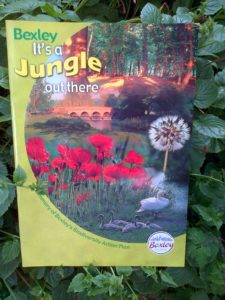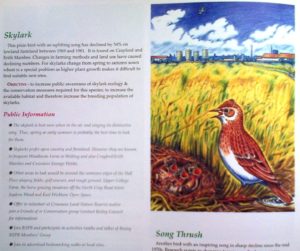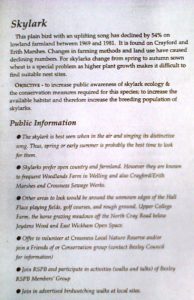Over the last year Bexley Council has approved building on two of the three known Skylark nesting sites in the Borough – the only Skylark breeding habitat on Erith Marshes, and on part of the main breeding site at Crayford Marshes – without any reference to its overall conservation status in the area. This is a red-listed species due to a massive 61% decline between 1967 and 2008. Recent acquisition of a hard copy of Bexley’s 2002 Biodiversity Action Plan reminds us of how the Council’s attitude had changed by the time of the replacement 2010 to 2015 BAP, by which point Skylark had been ditched (though it remains a UK and London BAP species). An objective of looking for ways of expanding the size of Erith Marshes/Crossness Local Nature Reserve had also conveniently vanished from the Council’s policy portfolio …….

Bexley Council’s first (2002) Biodiversity Action Plan. It now seems determined to insert the word ‘concrete’ before ‘jungle’.
Back in 2002 it is clear from the document that Bexley Council explicitly sought to increase the amount of Skylark habitat and thus the number of breeding Skylarks in the Borough. It also seems to have wanted the public to take an interest in the bird and to be able to carry on seeing it in Bexley. By 2016 the Biodiversity Officer was absurdly refusing to say – on the grounds it was the subject of a live planning application – whether Core Strategy policy CS18
c) resisting development that will have a significant impact on the population or conservation status of protected species and priority species as identified in the UK, London and Bexley Biodiversity Action Plans;
meant that as the Skylark was very low in numbers in Bexley and loss of any was now a significant impact, it should be so protected (or did it have to be the case that the last few in the whole UK had to be in Bexley to merit Bexley action?). A generic question to this effect, mentioning no particular species then went unanswered, and a chase-up got the response that ‘we decide these things on a case-by-case basis’. In other words Bexley admits making planning recommendations and decisions affecting wildlife of national conservation concern without reference to or provision of relevant, independent, published data, or the wider context or adherence to clearly defined policy – and therefore in a wholly unaccountable and opaque way.
Meanwhile, Bexley Council’s 2010-2015 Biodiversity Action Plan has expired, and to the best of our knowledge there has been no attempt whatsoever by the Council to talk to stakeholders, including groups and individuals that were helping to implement it, about reviewing progress or updating it or replacing it with some other document and ‘process’. The national biodiversity action plan monitoring website has been taken down and the London Biodiversity Partnership, which in theory drove the wider BAP process across the capital, has fallen apart.
Some kind of more dynamic ‘Local Biodiversity/Wildlife Partnership’ is needed to pick up the pieces.
Chris Rose


